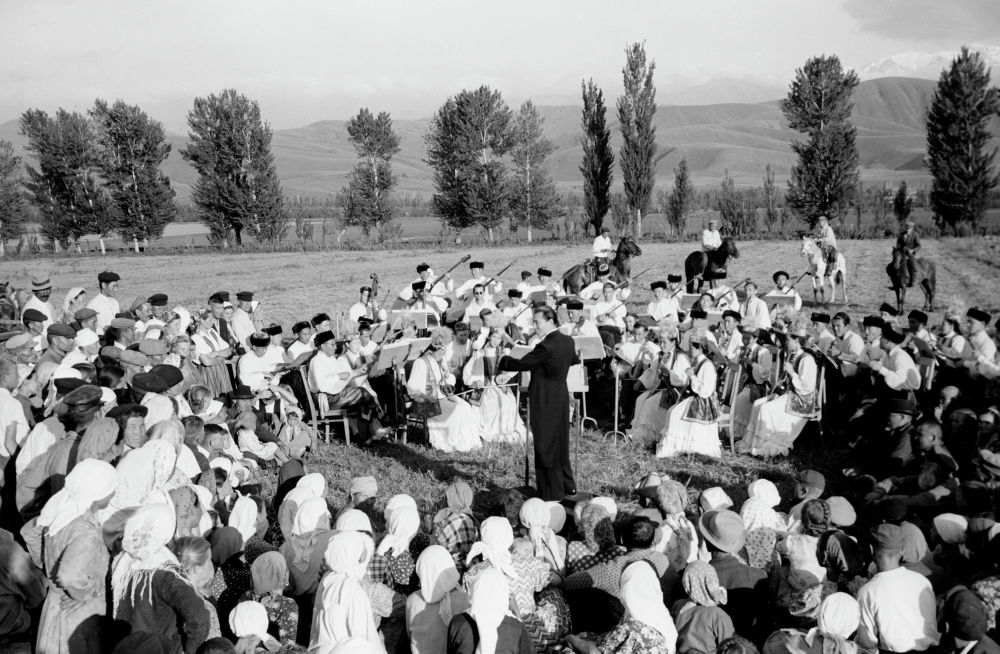ASTANA – Ninety years after its first concert, the Kurmangazy orchestra of Kazakh national instruments continues to color the vast landscape of Kazakh music, showcasing national instrumental culture to the world.

The orchestra employs dozens of talented musicians with a repertoire that includes over 4,000 pieces.Photo credit: kurmangazy.com
The orchestra is celebrating its anniversary throughout the year and across Kazakhstan.
“The foundation of each nation lies in its worldview, traditions, national culture and spirituality. The pinnacle of the spirituality of our people is Kazakh instrumental and musical art,” said the orchestra director Medet Kuanyshev in an interview with Kazinform news agency.
Orchestra founders
The Kurmangazy orchestra is unique among national instrumental ensembles, as it was the first of its kind in 1934.
Two names stood at the foundation of the orchestra: Temirbek Zhurgenov and Akhmet Zhubanov. One is a Soviet People’s Commissar of Education, who preserved the historical and cultural heritage by opening theaters, museums, film studies and a folk instrument orchestra. Zhubanov, a prominent figure in Kazakh classical music, served as the orchestra’s first conductor and artistic director.

Akhmet Zhubanov was the first conductor of the Kurmangazy Orchestra. Photo credit: Joseph Budnevich
“Zhurgenov organized the first All-Kazakhstan Gathering of Kazakh Folk art Workers, uniting unique figures of Kazakh art, when academician Zhubanov was entrusted with the significant task of creating an orchestra based on national musical instruments,” said Kuanyshev.
The history of the orchestra began with only 11 dombra players brought together by Zhubanov. He faced numerous challenges, as the folk musicians were used to performing solo and playing from memory and “by ear.” Zhubanov taught them to read music notation while also researching traditional compositions and building a repertoire.

Akhmet Zhubanov and the ensemble of folk instruments. Photo credit: qazaqculture.com
Zhubanov dedicated several years to refining and modernizing national instruments for orchestral performance. To support this effort, a musical-experimental workshop and research room were established at the Almaty Music and Drama Technical School, with Romanenko brothers, who were experienced in crafting Russian musical instruments, brought in to assist.
“Academician Zhubanov’s primary goal was to improve the musical education of dombra players, who, in the early years of the orchestra, amazed everyone with their natural talent. He aimed to bring their skills to an academic level. Through his collaboration with the dombra players, Zhubanov undertook creative and scholarly work, studying the kui [Kazakh musical composition] of Kurmangazy Sagyrbaiuly within the orchestra—a legacy that has become an enduring part of our cultural heritage,” said Kuanyshev.
In 1944, the orchestra was named after Kazakh composer Kurmangazy Sagyrbaiuly, and since then, it has served as a legacy of Kazakhstan’s greatest music genius of the 19th century. Last year, Kazakhstan marked the 200th anniversary of Kurmangazy.
The orchestra today
Many musicians dream of performing in the Kurmangazy orchestra, but only a select few have become part of the legendary ensemble. Today, it consists of 80 musicians and features Kazakh string instruments such as the dombra and qobyz. The principal conductor of the orchestra is Abylai Tlepbergen, the winner of the Daryn Youth Award.

The principal conductor of the orchestra is Abylai Tlepbergen, the winner of the Daryn Youth Award. Photo credit: Kurmangazy Kazakh National Orchestra of Folk Instruments
“He is a gifted talent who showcases the rich sound of the Kazakh dombra to the world through numerous national and international competitions. The young conductor’s new compositions, featured in the orchestra’s repertoire, have earned wide admiration and the attention of the general public,” said Kuanyshev about Tlepbergen.
Kurmangazy orchestra tackles an ambitious repertoire of Kazakh musical art classics such as Kurmangazy, Dauletkerey, and Dina Nurpeisova – works demanding talent and rehearsal time.
“In particular, each piece by Kurmangazy is our mascot, and the ‘Saryarka’ kui has become the orchestra’s ‘passport.’ Concluding every concert with this kui has become a lasting tradition,” said Kuanyshev.
The compositions of 20th-century Kazakh composers such as Nurgisa Tlendiev, Shamgon Kazhgaliev, and Aitkali Zhaiymov also hold a special place in the repertoire. The orchestra also experiments with new forms, merging world classical music with national repertoire.
The Kurmangazy orchestra has showcased Kazakh music in Russia, the Kyrgyz Republic, and Uzbekistan and plans to share a stage with the Russian Andreyevsky orchestra while organizing masterclasses.
Additionally, joint events are held in the Kyrgyz Republic and Uzbekistan to promote national culture and art. Efforts are also underway to build cultural connections with other countries, with plans for the orchestra to perform in Europe, Türkiye and China.


